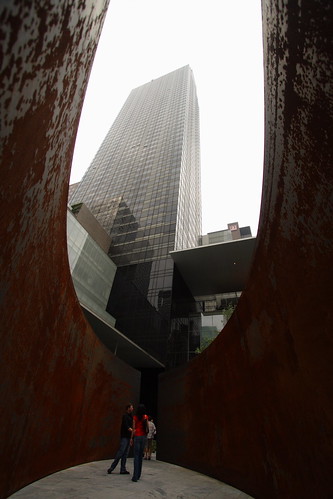 I managed to leave it to the death, but last Sunday morning, it occurred to me that the Richard Serra exhibition at the MoMA had come due, and I was compelled to brave the weekend tourist crowd to see it. I am a big fan of Serra's work, having first been introduced to it through installations at Stanford's Cantor Center, and been further impressed by his command of the main gallery at the Bilbao Guggenheim, by site-specific work at Storm King, and through encounters with his sculptures in Northern California.
I managed to leave it to the death, but last Sunday morning, it occurred to me that the Richard Serra exhibition at the MoMA had come due, and I was compelled to brave the weekend tourist crowd to see it. I am a big fan of Serra's work, having first been introduced to it through installations at Stanford's Cantor Center, and been further impressed by his command of the main gallery at the Bilbao Guggenheim, by site-specific work at Storm King, and through encounters with his sculptures in Northern California.While the MoMA show was ostensibly a forty year retrospective, including his work with vulcanized rubber, and forays into the formless mess of harnesses, the draw for me is always the massive plates of weathered steel snaking, arching, soaring, always forcing themselves into air and space, then disappearing, dull, rust, and mottled, into the near horizon. As sculpture, Serra's work challenges at every level: scale dwarfing the viewer, industrial materials that molt and flake like organic edifices, sheer geometries whose curves warp the edges of reality, and just-comprehensible density and mass that balances just-incomprehensibly. I'll let Robert Hughes do the talking, from his review of Serra's Bilbao installation:
Serra has embarked on a magnificent, productive maturity. Put in the simplest terms - ones that Serra might find too simple, but never mind - his achievement has been to give fabricated steel the power and density, the emotional address to the human body, the sense of empathy and urgency and liberation, that once belonged only to bronze and stone, but now no longer does. He has achieved a very deep synthesis, and it may not matter whether others follow him. Once you are in the enormous Guggenheim gallery which these sculptures fill, once you are absorbed in their space and pacing out their convolutions, you feel suddenly free - far from the dead zone of mass-media quotation, released from all that vulgar, tedious postmodernist litter and twitter, from the creepy posturings, tired bad-boy claptrap and squalid sanctimony that characterise PoMo and BritArt. It is quite a good feeling - rather like the old days, one's inner fogey is tempted to say. The work is as new as new could be, but when you are experiencing it you may also think of an 18th-century definition of the spirit of classical sculpture: "A noble inwardness," wrote Johann Winckelmann, "a calm grandeur."High praise, but echoing true. The only disappointment I felt at the MoMA exhibit was that aside from the mazy sculptures Band, Torqued Torus Inversion, and Sequence dominating the second floor, and even then, MoMA was not a great showcase for Serra's work - providing neither the dramatic backdrop of a natural context, grass, earth, and sky, that installations like Storm King or even courtyard settings like the Cantor museum provide, nor the cavernous solemnity of rooms like the Guggenheim in Bilbao. The MoMA never provided the sculptures a sufficiently rich environment to invert, negate, or warp.
Nevertheless, walking among the sculptures on a crowded day allowed me to appreciate Serra as high artist. His sculptures are the perfect gauntlet thrown down at the feet of Johnny Tourist -- engaging and destroying the snide "What is this? Is this art? This is just steel!" initial reaction of so many, morphing it into a craned neck appraisal tracing the sculpture's edge to the horizon, the close quarter examination of the weathering and rust marks on each plate, the impulse to touch, the measuring, arguing, and final marvel at the pure balance and weight of each piece. Watching children, dull-faced teenagers, and pink and white oldsters equally indulging in Serra's sculptures is a testament to the power of the work.
Pictures from a Flickr search for 'Richard Serra' (not necessarily depicting the MoMA show).



No comments:
Post a Comment